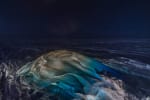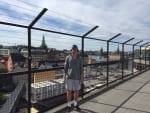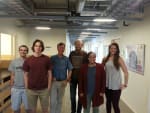Growing up on a small, secluded hobby farm in southwestern Wisconsin, the night sky played a major role in my upbringing. Since there is almost no light pollution, the night sky was always bright and clear. In the summer months, my bedtime was determined by the time a specific satellite went over the house. Every year, my family would gather up all the blankets in the house and lay outside to watch meteor showers for hours. From a young age, I loved the idea of learning more about the stars and planets, and as I got into high school, I fell in love with physics. My original plan was to become a high school physics teacher, and I found the University of Wisconsin–River Falls (UWRF) not only has a fantastic physics program but is also involved with IceCube. I had heard about IceCube in 2013, when it won Physics World’s Breakthrough of the Year, and working for IceCube became my new goal and dream. […]
News
Week 32 at the Pole
The igloo—the prime attraction at the South Pole for the last few weeks—is no more. But before “disappearing,” its existence was memorialized in some final photos. Here you can see it with the names of its builders carved into the side, and it appears to almost glow from the soft white light from within. […]
Investigating excess of neutrinos from the galactic plane, summer research with IceCube
During my summer abroad, I worked with Dr. Jon Dumm, who is searching for an excess of neutrino events originating in the plane of the Milky Way. Dr. Dumm’s analysis is designed to look for a diffuse neutrino flux from the galactic plane in agreement with a map of where pion decay is expected to occur. However, this analysis is sensitive to a neutrino flux from point sources that are not necessarily distributed as the pion decay map predicts. We simulated four possible models of cosmic-ray source density in the galaxy as proxies for possible distributions of unresolved neutrino point sources. In doing so, we established limits on the total flux from various numbers of sources to which the primary pion-decay-based analysis is sensitive. […]
Supernova filters and building an IceCube model, summer research with IceCube
At the start of the summer, UW-River Falls student Nick Jensen and I set out to create a 1:1000 scale model of the IceCube detector using LEDs to represent DOMs. To do this, we needed a wide assortment of parts to construct the model from the ground up. We spent the first half of the summer trying to gather all the parts needed for building. […]
Week 31 at the Pole
The igloo from last week is finally finished. What began as an afternoon project ended up taking an entire week (well, high winds were partly to blame). In the image, you can see the igloo lit from within, and perhaps even discern that there are only few blocks missing to complete the ceiling. […]
Week 30 at the Pole
That’s not the IceCube Lab all frosted up in this photo but the ARO (Atmospheric Research Observatory) building, with its LIDAR beams shown shooting straight up into the sky. […]
IceCube search for the ‘sterile neutrino’ draws a blank
In an effort to fill in the blanks of the Standard Model of particle physics, science has been conducting a diligent search for a hypothesized particle known as the “sterile neutrino.” Now, with the latest results from an icy particle detector at the South Pole, scientists are almost certain that there is no such particle. […]
Week 29 at the Pole
Station life was quiet at the South Pole last week, but not too quiet. They celebrated Christmas in July with a special dinner. Popular in many parts of the world, for various reasons, Christmas in July is only one of numerous celebrations held throughout the year at the Pole. […]
Week 28 at the Pole
In summer at the South Pole, the traditional place for photo ops is the ceremonial Pole, where a mirrored sphere is mounted on a post and surrounded by a semicircular lineup of flags. But in the dark of winter, any place is as good as another as long as you have a nice aurora as backdrop […]
Deciphering the cosmic muon neutrino flux in IceCube
The IceCube Collaboration is now accumulating more statistics in the search for the sources of very high energy neutrinos, but also to learn more about their nature. In a new study, submitted this week to the Astrophysical Journal, the collaboration reports a substantially improved observation of the diffuse muon neutrino flux in the Northern Hemisphere using six years of IceCube data with about a tenfold increase in statistics. Once more, a clear astrophysical contribution has been found, which at the highest energies excludes a purely atmospheric origin at the 5.6 sigma level. Also, the accuracy of the measurement of the spectral properties has been improved.
[…]









